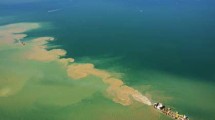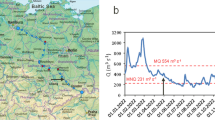Abstract
This paper presents a general, process-based model for suspended particulate matter (SPM) in defined coastal areas (the ecosystem scale). The model is based on ordinary differential equations and the calculation time (dt) is 1 month to reflect seasonal variations. The model has been tested using data from 17 Baltic coastal areas of different character and shown to predict mean monthly SPM-concentrations in water and Secchi depth (a measure of water clarity) very well (generally within the uncertainty bands given by the empirical data). The model is based on processes regulating inflow, outflow and internal fluxes. The separation between the surface-water layer and the deep-water layer is not done in the traditional manner from water temperature data but from sedimentological criteria (from the wave base which regulates where wind/wave-induced resuspension occurs). The model calculates the primary production of SPM (within the coastal areas), resuspension, sedimentation, mixing, mineralization and retention of SPM. The SPM-model is simple to apply in practice since all driving variables may be readily accessed from maps or regular monitoring programs. The model has also been extensively tested by means of sensitivity and uncertainty tests and the most important factor regulating model predictions of SPM-concentrations in coastal water is generally the value used for the SPM-concentration in the sea outside the given coastal area. The obligatory driving variables include four morphometric parameters (coastal area, section area, mean and maximum depth), latitude (to predict surface water and deep water temperatures, stratification and mixing), salinity, chlorophyll and the Secchi depth or SPM-concentration in the sea outside the given coastal area. Many of the structures in the model are general and could potentially be used for coastal areas other than those included in this study, e.g., for open coasts, estuaries or areas influenced by tidal variations.
Similar content being viewed by others
References
Abdel-Moati MAR (1997) Industrial dumping impact on oxygen and nitrogen fluxes in Abu Qir Bay, southeastern Mediterranean Sea. Environ Int 23(3):349–357
Aertbjerg G (ed) (2001) Eutrophication in Europeȁ9s coastal waters. European Environment Agency, Topic report 7/2002, Copenhagen, p 86
Ambio (1990) Special issue. Mar Eutrophication 19:102–176
Ambio (2000) Eutrophication and contaminants in the aquatic environment. Nr. 4–5:183–290
Andreev A, Kusakabe M, Honda M, Murata A, Saito C (2002) Vertical fluxes of nutrients and carbon through the halocline in the western subarctic Gyre calculated by mass balance. Deep-Sea Res II 49:5577–5593
Blomqvist S (1992) Geochemistry of coastal Baltic sediments: processes and sampling procedures. Dr. thesis, Stockholm Univ., Sweden
Burban P-Y, Lick W, Lick J (1989) The flocculation of fine-grained sediments in estuarine waters. J Geophys Res 94:8223–8330
Burban P-Y, Xu Y-J, McNeiel J, Lick W (1990) Settling speeds of flocs in freash water and seawater. J Geophys Res 95:18213–18220
Carlsson L, Persson J, Håkanson L (1999) A management model to predict seasonal variability in oxygen concentration and oxygen consumption in thermally stratified coastal waters. Ecol Modelling 119:117–134
De Schmedt F, Vuksanovic V, Van Meerbeeck S, Reyns D (1998) A time-dependent flow model for heavy metals in the Scheldt estuary. Hydrobiologia 366:143–155
Douglas RW, Rippey B, Gibson CE (2003) Estimation of the in-situ settling velocity of particles in lakes using a time series sediment trap. Freshwater Biol 48:512–518
Dyer JL (1979) Estuarine hydrography and sedimentation. Cambridge Univ. Press, Cambridge, p 230
Gray JR, Glysson GD, Turcios LM, Schwarz GE (2000) Comparability of suspended-sediment concentrations and total suspended solids data. U.S. Geol. Survey, Report 00–4191, Reston, Virginia, p 14
Håkanson L (1999) Water pollution—methods and criteria to rank, model and remediate chemical threats to aquatic ecosystems. Backhuys Publishers, Leiden, p 299
Håkanson L (2000) Modelling radiocesium in lakes and coastal areas—new approaches for ecosystem modellers. A textbook with Internet support. Kluwer Academic Publishers, Dordrecht, p 215
Håkanson L (2006) Suspended particulate matter in lakes, rivers and marine systems. The Blackburn Press, 992 New Jersey, p 331
Håkanson L, Blenckner T, Malmaeus JM (2004b) New, general methods to define the depth separating surface water from deep water, outflow and internal loading for mass-balance models for lakes. Ecol Modelling 175:339–352
Håkanson L, Boulion V (2002) The Lake Foodweb—modelling predation and abiotic/biotic interactions. Backhuys Publishers, Leiden, p 344
Håkanson L, Gyllenhammar A, Brolin A (2004a) A dynamic model to predict sedimentation and suspended particulate matter in coastal areas. Ecol Modelling 175:353–384
Håkanson L, Jansson M (1983) Principles of lake Sedimentology. Springer, Berlin, p 316
Håkanson L, Karlsson M (2004) A dynamic model tro predict phosphorus fluxes, concentrations and eutropications effects in Baltic coastal areas. In: Karlsson M (ed) Predictive modelling—a tool for aquatic environmental management. Thesis, Dept. of Earth Sci., Uppsala Univ., p 108
Håkanson L, Kulinski I, Kvarnäs H (1984) Water dynamics and bottom dynamics in coastal areas (in Swedish, Vattendynamik och bottendynamik i kustzonen). SNV PM 1905, Solna, p 228
Håkanson L, Kvarnäs H, Karlsson B (1986) Coastal morphometry as regulator of water exchange—a Swedish example. Estuar Coastal Shelf Sci 23:1–15
Heiskanen A-S, Tallberg P (1999) Sedimentation and particulate nutrient dynamics along a coastal gradient from a fjord-like bay to the open sea. Hydrobiologia 393:127–140
Jonsson P (1992) Large-scale changes of contaminants in Baltic Sea sediments during the twentieth century. Thesis, Uppsala University, Sweden
Lundin LC (1999) Water in Society. Sustainable water management in the Baltic Sea basin. The Baltic Univ. Progr., Uppsala Univ., p 244
Lundin LC (2000a) The Waterscape. Sustainable water management in the Baltic Sea basin. The Baltic Univ. Progr., Uppsala Univ., p 207
Lundin LC (2000b) River Basin Management. Sustainable water management in the Baltic Sea basin. The Baltic Univ. Progr., Uppsala Univ., p 244
Mann KH (1982) Ecology of coastal waters. A systems approach. Blackwell Scientific Publications, Oxford, p 322
Matteucci G, Frascari F (1997) Fluxes of suspended materials in the north Adriatic Sea (Po prodelta area). Water Air Soil Pollution 99:557–572
McCave IN (1981) Location of coastal accumulations of fine sediments around the southern North Sea. Rapp P v Reun Int Explor Mer 181:15–27
Meeuwig JJ, Kauppila P, Pitkänen H (2000) Predicting coastal eutrophication in the Baltic: a limnological approach. Can J Fish Aquat Sci 57:844–855
Monte L, Håkanson L, Periañez R, Laptev G, Zheleznyak M, Maderich V, Koshebutsky V (2005) Experienxces from a case-study of multi-model application to assesss the behaviour of pollutants in the Dnieper-Bug estuary. Manuscript, ENEA, Rome
Muir Wood AM (1969) Coastal hydraulics. Macmillan, London, p 187
Ottosson F, Abrahamsson O (1998) Presentation and analysis of a model simulating epilimnetic and hypolimnetic temperatures in lakes. Ecol Modelling 110:223–253
Pearson TH, Rosenberg R (1976) A comparative study on the effects on the marine environment of wastes from cellulose industries in Scotland and Sweden. Ambio 5:77–79
Persson J, Håkanson L, Pilesjö P (1994) Prediction of surface water turnover time in coastal waters using digital bathymetric information. Environmentrics 5:433–449
Persson J, Håkanson L (1995) Prediction of bottom dynamic conditions in coastal waters. Mar Freshw Res 46:359–371
Persson J, Håkanson L (1996) A simple empirical model to predict deepwater turnover time in coastal waters. Can J Fish Aq Sci 53:1236–1245
Pilesjö P, Persson J, Håkanson L (1991) Digital bathymetric information for calculations of morphometrical parameters and surface water retention time for coastal areas (in Swedish). National Swedish Environmental Protection Agency (SNV) Report no. 3916, Solna, Sweden
Postma H (1982) Sediment transport and sedimentation. In: Olausson E, Cato I (eds) Chemistry and biogeochemistry of estuaries. Wiley & Sons, Chichester, pp 153–186
Remane A (1934) Die Brackwasserfauna. Verh Dt Zool Ges 36:34–74
Rosenberg R (1985) Eutrophication—the future marine coastal nuisance? Mar Pollut Bull 16:227–231
Sandberg J, Elmgren R, Wulff F (2000) Carbon flows in Baltic Sea food webs—a re-evaluation using a mass balance approach. J Mar Systems 25:249–260
Seibold E, Berger WH (1982) The sea floor. Springer-Verlag, Heidelberg, p 288
Stanley DJ, Swift DJ (eds) (1976) Marine sediment transport and environmental management. Wiley & Sons, New York, p 602
Voipio A (ed) (1981) The Baltic Sea. Elsevier Oceanographic Series, Amsterdam, p 418
Vollenweider RA (1968) The scientific basis of lake eutrophication, with particular reference to phosphorus and nitrogen as eutrophication factors. Tech Rep DAS/DSI/68.27, OECD, Paris, pp 159
Wallin M, Håkanson L (1991) Morphometry and sedimentation as regulating factors for nutrient recycling in shallow coastal waters. Hydrobiologia 75:33–46
Wallin M, Håkanson L, Persson J (1992) Load models for nutrients in coastal areas, especially from fish farms (in Swedish with English summary). Nordiska ministerrådet, 1992:502, Copenhagen, p 207
Wulff F, Rahm L, Larsson P (eds) (2001) A systems analysis of the Baltic Sea. Springer-Verlag, Berlin, Ecological studies 148, p 455
Acknowledgements
This work has been carried out as a preparation for the Threshold-project, and integrated EU-project coordinated by Prof. Carlos M. Duarte, CSIC-Univ. Illes Balears, Spain. I would also like to thank an anonymous reviewer for very many constructive remarks and suggestions.
Author information
Authors and Affiliations
Corresponding author
Rights and permissions
About this article
Cite this article
Håkanson, L. A revised dynamic model for suspended particulate matter (SPM) in coastal areas. Aquat Geochem 12, 327–364 (2006). https://doi.org/10.1007/s10498-006-9001-9
Received:
Accepted:
Published:
Issue Date:
DOI: https://doi.org/10.1007/s10498-006-9001-9




